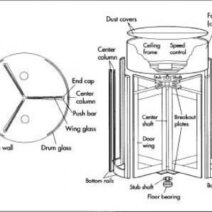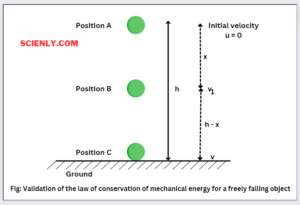In the realm of physics, energy is an omnipresent force that governs the behavior of physical systems. Among the various forms of energy, the principle of conservation of mechanical energy stands out as a fundamental concept that elucidates the dynamic interplay between potential and kinetic energy. This article delves into the intricacies of mechanical energy conservation, its implications, and its significance in natural and engineered systems.
Understanding the conservation of mechanical energy requires an examination of two primary forms: potential energy and kinetic energy. Potential energy is the stored energy associated with the position of an object within a gravitational field, while kinetic energy pertains to the energy of motion. The relationship between these two forms of energy is encapsulated in the law of conservation of mechanical energy, which asserts that in the absence of non-conservative forces such as friction or air resistance, the total mechanical energy of a system remains constant.
This principle is not merely a theoretical construct but has far-reaching applications in various fields, ranging from engineering to environmental science. By harnessing the energy principles at play, one can develop systems that optimize energy usage, thus promoting sustainability and efficiency.
Exploring Potential Energy: The Stored Force
Potential energy can be categorized into various types, with gravitational potential energy being the most prevalent in everyday contexts. The formula for gravitational potential energy (PE) is defined as PE = mgh, where m represents mass, g denotes the acceleration due to gravity, and h signifies the height above a reference point. This form of energy is significant in systems ranging from simple pendulums to complex roller coasters, where the height of the mass dictates its potential energy.
In geological processes, potential energy is also crucial. For instance, when water is contained in a reservoir behind a dam, the potential energy it possesses due to its elevated position can be transformed into kinetic energy, driving turbines to generate electricity. This transformation exemplifies the effective harnessing of natural resources through an understanding of potential energy’s role.
Additionally, the concept of elastic potential energy emerges in systems that involve deformation, such as springs. When a spring is compressed or stretched, it stores energy that can be released when it returns to its equilibrium position. This form of potential energy plays a vital role in various applications, including mechanical clocks and numerous automotive systems.
Kinetic Energy: The Energy of Motion
Kinetic energy (KE), on the other hand, is associated with the mass in motion and is calculated using the formula KE = ½ mv², where m represents mass and v indicates velocity. Kinetic energy is paramount in analyzing motion, imparting insights into the behavior of moving objects under different forces.
For example, consider two cars of equal mass traveling at different speeds. Although they possess the same mass, the car moving at a higher velocity will have significantly greater kinetic energy due to the square relationship with speed. Such principles are vital in safety engineering and crash analysis, informing designs that can withstand the forces generated during collisions.
Moreover, kinetic energy underpins many aspects of sports science. Athletes strive to maximize their kinetic energy output through optimal techniques, allowing them to achieve greater velocities and performance metrics. Understanding the relationship between kinetic energy and motion fosters advancements in training regimens and injury prevention strategies.
The Conservation Principle in Practice
The beauty of mechanical energy conservation is its practicality. In an ideal system devoid of external forces, the total energy remains constant throughout the motion. This principle is beautifully illustrated in the classic example of a swinging pendulum. At the apex of its swing, the pendulum possesses maximum potential energy and minimal kinetic energy. As it descends, potential energy is converted into kinetic energy, reaching its peak kinetic energy at the lowest point of the swing. This cyclical transformation continues, demonstrating how energy can seamlessly shift forms while maintaining a constant total mechanical energy within the system.
In real-world applications, however, systems often experience energy loss due to non-conservative forces, leading to the dissipation of energy as heat or sound. In engineering applications, understanding these losses is crucial for designing efficient machines. For instance, cars are engineered to minimize energy loss due to friction, allowing for better fuel efficiency.
Ecological Perspectives: Energy Conservation and Sustainability
The conservation of mechanical energy resonates beyond physics and engineering, extending into the ecological realm. As humanity grapples with pressing environmental concerns, the efficient use of energy becomes paramount. Renewable energy technologies, such as wind turbines and hydroelectric dams, draw on these principles, converting potential energy from natural sources into usable forms. They exemplify the harmonious relationship between technology and nature, wherein understanding energy conservation paves the way for sustainable practices.
The conservation ethos also finds its way into architecture, where energy-efficient designs prioritize the optimization of both mechanical and thermal energy. Integrating passive solar design or utilizing wind energy can drastically reduce energy consumption within buildings, promoting a sustainable future.
Conclusion: A Fundamental Paradigm
The conservation of mechanical energy is a principle that transcends disciplines, informing our understanding of physical systems from the microcosm of particles to the macrocosm of planetary motion. By comprehending the nuances of potential and kinetic energy, we gain insights that are applicable not only in scientific endeavors but also in our collective journey toward a sustainable future. Embracing these principles allows us to harness energy more efficiently, minimizing waste and maximizing the potential inherent in natural systems. The quest for sustainability necessitates a profound recognition of energy’s role, illuminating pathways toward a harmonious coexistence with our environment.








